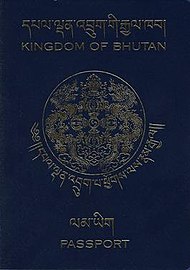A Bhutanese passport is a document which authorizes and facilitates travel and other activities in Bhutan or by Bhutanese citizens. Foreign travel passports are issued to citizens of Bhutan for international travel by the Ministry of Foreign Affairs. It is valid for all countries unless otherwise endorsed.[2]
| Bhutanese passport | |
|---|---|
 The front cover of an ordinary (blue) Bhutanese passport | |
| Type | Passport |
| Issued by | |
| First issued | app. 2006[1] (current version) |
| Purpose | Identification |
| Eligibility | Bhutanese citizenship |
| Expiration | Ten years |
History

In the Kingdom of Bumthang, which constitutes a part of modern-day Bhutan, feudal passbooks or dzeng (Dzongkha: ཛེང) were issued to court messengers in order to travel from kingdom to kingdom.[2] Diplomacy and mediating were crucially important measures in pre-modern Bhutan chiefdoms.[3]
Foreign travel passports are issued to citizens of Bhutan for international travel. New Bhutanese passports are issued by the Ministry of Foreign Affairs.
In 1988, Bhutanese passport holders abroad were ordered to surrender their passports upon their return to Bhutan.[4]
The current version of the Bhutanese passports were first issued around 2006.
Languages
Types of passport
In popular culture
In 2013, a spoken article on the English Wikipedia was created for the Bhutanese passport by user KuchenZimjah,[6] which was interpreted as humorous, spawning an internet meme. The audio file was deleted in 2015 following debate on the article's talk page.[7][8] In 2023, YouTube creator Hbomberguy used this recording as an example of audio versions of articles being an accessibility feature and of recreating someone else's creative work in an ethical, productive way.[9]
See also
References
External links
Wikiwand in your browser!
Seamless Wikipedia browsing. On steroids.
Every time you click a link to Wikipedia, Wiktionary or Wikiquote in your browser's search results, it will show the modern Wikiwand interface.
Wikiwand extension is a five stars, simple, with minimum permission required to keep your browsing private, safe and transparent.



